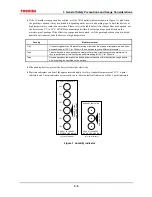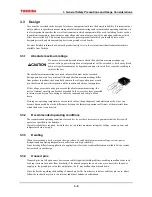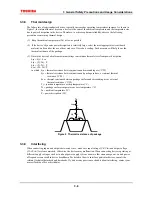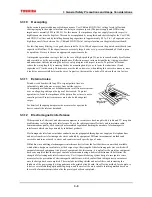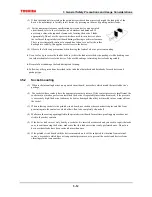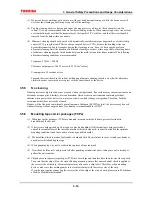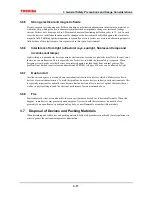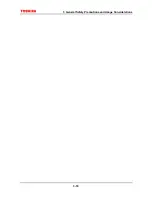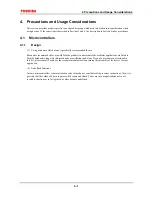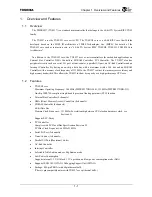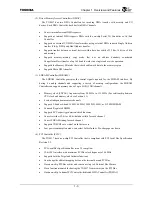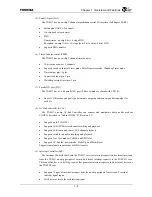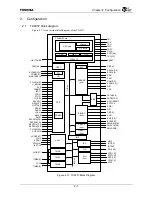
3 General Safety Precautions and Usage Considerations
3-16
3.5.10 Tightening
torque
(1) Make sure the screws are tightened with fastening torques not exceeding the torque values stipulated in
individual datasheets and databooks for the devices used.
(2) Do not allow a power screwdriver (electrical or air-driven) to touch devices.
3.5.11
Repeated device mounting and usage
Do not remount or re-use devices which fall into the categories listed below; these devices may cause significant
problems relating to performance and reliability.
(1) Devices which have been removed from the board after soldering
(2) Devices which have been inserted in the wrong orientation or which have had reverse current applied
(3) Devices which have undergone lead forming more than once
3.6
Protecting Devices in the Field
3.6.1 Temperature
Semiconductor devices are generally more sensitive to temperature than are other electronic components. The
various electrical characteristics of a semiconductor device are dependent on the ambient temperature at which
the device is used. It is therefore necessary to understand the temperature characteristics of a device and to
incorporate device derating into circuit design. Note also that if a device is used above its maximum temperature
rating, device deterioration is more rapid and it will reach the end of its usable life sooner than expected.
3.6.2 Humidity
Resin-molded devices are sometimes improperly sealed. When these devices are used for an extended period of
time in a high-humidity environment, moisture can penetrate into the device and cause chip degradation or
malfunction. Furthermore, when devices are mounted on a regular printed circuit board, the impedance between
wiring components can decrease under high-humidity conditions. In systems which require a high signal-source
impedance, circuit board leakage or leakage between device lead pins can cause malfunctions. The application
of a moisture-proof treatment to the device surface should be considered in this case. On the other hand,
operation under low-humidity conditions can damage a device due to the occurrence of electrostatic discharge.
Unless damp-proofing measures have been specifically taken, use devices only in environments with appropriate
ambient moisture levels (i.e. within a relative humidity range of 40% to 60%).
3.6.3 Corrosive
gases
Corrosive gases can cause chemical reactions in devices, degrading device characteristics.
For example, sulphur-bearing corrosive gases emanating from rubber placed near a device (accompanied by
condensation under high-humidity conditions) can corrode a device’s leads. The resulting chemical reaction
between leads forms foreign particles which can cause electrical leakage.
3.6.4
Radioactive and cosmic rays
Most industrial and consumer semiconductor devices are not designed with protection against radioactive and
cosmic rays. Devices used in aerospace equipment or in radioactive environments must therefore be shielded.
Summary of Contents for TX49 TMPR4937
Page 1: ...64 Bit TX System RISC TX49 Family TMPR4937 Rev 2 0 ...
Page 4: ......
Page 13: ...Table of Contents ix TMPR4937 Revision History 1 ...
Page 14: ...Table of Contents x ...
Page 15: ...Handling Precautions ...
Page 16: ......
Page 18: ...1 Using Toshiba Semiconductors Safely 1 2 ...
Page 40: ...3 General Safety Precautions and Usage Considerations 3 18 ...
Page 42: ...4 Precautions and Usage Considerations 4 2 ...
Page 43: ...TMPR4937 2005 3 Rev 2 0 ...
Page 44: ......
Page 52: ...Chapter 1 Overview and Features 1 6 ...
Page 156: ...Chapter 7 External Bus Controller 7 56 ...
Page 491: ...Chapter 16 Removed 16 1 16 Removed ...
Page 492: ...Chapter 16 Removed 16 2 ...
Page 493: ...Chapter 17 Removed 17 1 17 Removed ...
Page 494: ...Chapter 17 Removed 17 2 ...
Page 495: ...Chapter 18 Removed 18 1 18 Removed ...
Page 496: ...Chapter 18 Removed 18 2 ...
Page 497: ...Chapter 19 Removed 19 1 19 Removed ...
Page 498: ...Chapter 19 Removed 19 2 ...
Page 506: ...Chapter 20 Extended EJTAG Interface 20 8 ...
Page 530: ...Chapter 22 Pinout and Package Information 22 10 ...
Page 542: ...Chapter 24 Parts Number when Ordering 24 2 ...




